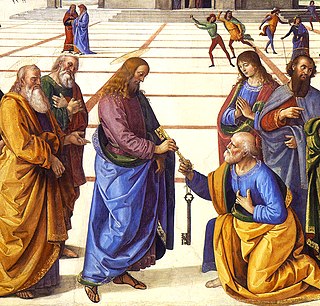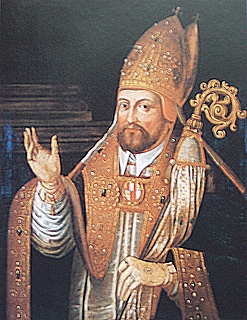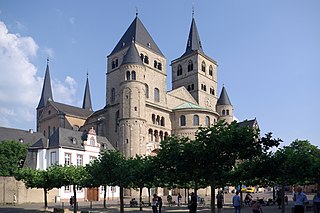
Primate is a title or rank bestowed on some important archbishops in certain Christian churches. Depending on the particular tradition, it can denote either jurisdictional authority or (usually) ceremonial precedence.

A prince-bishop is a bishop who is also the civil ruler of some secular principality and sovereignty. Thus the principality or prince-bishopric ruled politically by a prince-bishop could wholly or largely overlap with his diocesan jurisdiction, but some parts of his diocese, even the city of his residence, could be exempt from his civil rule, obtaining the status of free imperial city. If the episcopal see is an archbishop, the correct term is prince-archbishop; the equivalent in the regular (monastic) clergy is prince-abbot. A prince-bishop is usually considered an elected monarch.

The Diocese of Mainz, historically known in English by its French name of Mayence is a Latin rite of the Catholic church in Germany. It was founded in 304, promoted in 780 to Metropolitan Archbishopric of Mainz and demoted back in 1802 to bishopric. The diocese is suffragan diocese in the ecclesiastical province of the Metropolitan Archdiocese of Freiburg. Its district is located in the states of Rhineland-Palatinate and Hesse. The seat of the diocese is in Mainz at the Cathedral dedicated to Saints Martin and Stephen. It is the only Roman Catholic diocese in the world – other than Rome – which bears the title of a Holy See.
In the Catholic Church, a titular church is a church in Rome that is assigned to a member of the clergy who is created a cardinal. These are Catholic churches in the city, under the Diocese of Rome, that serve as honorary designations symbolising the relationship of cardinals to the pope, the bishop of Rome. According to the 1983 Code of Canon Law, a cardinal may assist his titular church through counsel or through patronage, although "he has no power of governance over it, and he should not for any reason interfere in matters concerning the administration of its good, or its discipline, or the service of the church".

The Bishop of Chur is the ordinary of the Roman Catholic Diocese of Chur, Grisons, Switzerland.

The Electorate of Trier, traditionally known in English by its French name of Trèves, was an ecclesiastical principality of the Holy Roman Empire that existed from the end of the 9th to the early 19th century. It consisted of the temporal possessions of the prince-archbishop of Trier, also a prince-elector of the empire, along with the Elector of Cologne and the Elector of Mainz, among which the latter ranked first.

The Roman Catholic Archdiocese of Luxembourg is an archdiocese of the Latin Rite of the Catholic Church in the Grand Duchy of Luxembourg, comprising the entire Grand Duchy. The diocese was founded in 1870, and it became an archdiocese in 1988. The seat of the archdiocese is the Cathedral of Notre Dame in the city of Luxembourg, and since 2011 the archbishop is Jean-Claude Hollerich.

Saint Nicetius was a bishop of Trier, born in the latter part of the fifth century, exact date unknown; died in 563 or more probably 566.

Saint Aprunculus of Trier was Bishop of Trier from the death of his predecessor, Fibicius, whether in 511 or 525, and served in that capacity until his own death, which is presumed to have occurred before the appointment of his successor Nicetius.

The Roman Catholic diocese of Trier, in English traditionally known by its French name of Treves, is a diocese of the Latin Rite of the Roman Catholic church in Germany. When it was the archbishopric and Electorate of Trier, it was one of the most important states of the Holy Roman Empire, both as an ecclesiastical principality and as a diocese of the Church. Unlike the other Rhenish dioceses — Mainz and Cologne, Trier was the former Roman provincial capital of Augusta Treverorum. Given its status, Trier has always been the seat of a bishop since Roman times, one of the oldest dioceses in all of Germany. The diocese was elevated to an archdiocese in the time of Charlemagne and was the metropolitan for the dioceses of Metz, Toul, and Verdun. After the victory of Napoleon Bonaparte of France, the archdiocese was lowered to a diocese and is now a suffragan of the Archdiocese of Cologne. The diocesan cathedral is the Cathedral of Saint Peter.
Gaul was an important early center of Latin Christianity in late antiquity and the Merovingian period. By the middle of the 3rd century, there were several churches organized in Roman Gaul, and soon after the cessation of persecution the bishops of the Latin world assembled at Arles, in AD 314. The Church of Gaul passed through three dogmatic crises in the late Roman period, Arianism, Priscillianism and Pelagianism. Under Merovingian rule, a number of "Frankish synods" were held, marking a particularly Germanic development in the Western Church. A model for the following Frankish synods was set by Clovis I, who organized the First Council of Orléans (511).

Leontius of Trier was bishop of Trier from 414–445.

Mauricius or Mauritius of Trier was bishop of Trier from 398/399 to at least 407, and possibly as late as 419.
Fibicius was Bishop of Trier from around 502 to 525 or so.
Maximianus of Trier was bishop of Trier around the turn of the 5th and 6th centuries.

Cyril of Trier was Bishop of Trier from the beginning of the second half of the 5th century bishop of Trier. Some think he was a Greek.

Severus von Trier was Bishop of Trier from about 445/446. He proselytized to and contributed to the conversion of Germanic peoples living in the regions of the lower Moselle and Middle Rhine.

Britto of Trier was bishop of Trier.

Iamblichus of Trier also known as Jamblichus or Jamblychus was a 5th-century bishop of Trier from 475/76.

Gunderich of Trier, also Gundwich was a bishop of Trier, born in the 6th century.










